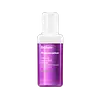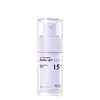What's inside
What's inside
 Key Ingredients
Key Ingredients

 Benefits
Benefits

 Concerns
Concerns

 Ingredients Side-by-side
Ingredients Side-by-side

Water
Skin ConditioningButylene Glycol
HumectantDipropylene Glycol
HumectantGlycerin
HumectantPropanediol
Solvent1,2-Hexanediol
Skin ConditioningDimethicone Crosspolymer
Emulsion StabilisingBakuchiol
AntimicrobialVinyldimethicone
Hydrolyzed Collagen
EmollientEthylhexylglycerin
Skin ConditioningAllantoin
Skin ConditioningBiosaccharide Gum-1
HumectantDipotassium Glycyrrhizate
HumectantAdenosine
Skin ConditioningSodium Dilauramidoglutamide Lysine
HumectantHydrogenated Lecithin
EmulsifyingSodium Polyacryloyldimethyl Taurate
Emulsion StabilisingIsododecane
EmollientAcrylates/C10-30 Alkyl Acrylate Crosspolymer
Emulsion StabilisingTromethamine
BufferingParfum
MaskingDisodium EDTA
Tocopherol
AntioxidantPhenoxyethanol
PreservativeSodium Benzoate
MaskingCI 14700
Cosmetic ColorantCI 42090
Cosmetic ColorantWater, Butylene Glycol, Dipropylene Glycol, Glycerin, Propanediol, 1,2-Hexanediol, Dimethicone Crosspolymer, Bakuchiol, Vinyldimethicone, Hydrolyzed Collagen, Ethylhexylglycerin, Allantoin, Biosaccharide Gum-1, Dipotassium Glycyrrhizate, Adenosine, Sodium Dilauramidoglutamide Lysine, Hydrogenated Lecithin, Sodium Polyacryloyldimethyl Taurate, Isododecane, Acrylates/C10-30 Alkyl Acrylate Crosspolymer, Tromethamine, Parfum, Disodium EDTA, Tocopherol, Phenoxyethanol, Sodium Benzoate, CI 14700, CI 42090
Water
Skin ConditioningPropanediol
SolventNiacinamide
SmoothingButylene Glycol
HumectantCaprylic/Capric Triglyceride
MaskingGlycerin
HumectantPolyglyceryl-3 Distearate
EmulsifyingMethyl Trimethicone
Skin ConditioningSqualane
Emollient1,2-Hexanediol
Skin ConditioningPanthenol
Skin ConditioningGlyceryl Stearate
EmollientPolyglyceryl-6 Stearate
EmollientCetearyl Alcohol
EmollientBorago Officinalis Extract
EmollientDiphenyl Dimethicone
EmollientBakuchiol
AntimicrobialCaprylyl Glycol
EmollientTriethylhexanoin
MaskingCarbomer
Emulsion StabilisingHydroxyethyl Acrylate/Sodium Acryloyldimethyl Taurate Copolymer
Emulsion StabilisingTromethamine
BufferingTocopherol
AntioxidantAllantoin
Skin ConditioningDipotassium Glycyrrhizate
HumectantXanthan Gum
EmulsifyingGlyceryl Stearate Citrate
EmollientPolyglyceryl-10 Oleate
Skin ConditioningHydrogenated Lecithin
EmulsifyingDisodium EDTA
Adenosine
Skin ConditioningPolyglyceryl-6 Behenate
Emulsion StabilisingEthylhexylglycerin
Skin ConditioningCentella Asiatica Leaf Extract
Skin ConditioningDipropylene Glycol
HumectantFructooligosaccharides
HumectantSorbitan Isostearate
EmulsifyingPisum Sativum Extract
Skin ConditioningEel Extract
HumectantRosa Alba Leaf/Stem Extract
HumectantCetyl Ethylhexanoate
EmollientPyrus Malus Fruit Extract
Skin ConditioningFragaria Chiloensis Fruit Extract
Skin ConditioningSodium Hyaluronate Crosspolymer
HumectantHydrolyzed Collagen
EmollientSodium Ascorbyl Phosphate
AntioxidantLavandula Angustifolia Flower Extract
CleansingCeramide NP
Skin ConditioningCholesterol
EmollientLinoleic Acid
CleansingPalmitic Acid
EmollientSodium Hyaluronate
HumectantBifida Polysaccharide
HumectantMalus Domestica Fruit Cell Culture Extract
Skin ConditioningCentella Asiatica Extract
CleansingSodium Dna
Skin ConditioningWater, Propanediol, Niacinamide, Butylene Glycol, Caprylic/Capric Triglyceride, Glycerin, Polyglyceryl-3 Distearate, Methyl Trimethicone, Squalane, 1,2-Hexanediol, Panthenol, Glyceryl Stearate, Polyglyceryl-6 Stearate, Cetearyl Alcohol, Borago Officinalis Extract, Diphenyl Dimethicone, Bakuchiol, Caprylyl Glycol, Triethylhexanoin, Carbomer, Hydroxyethyl Acrylate/Sodium Acryloyldimethyl Taurate Copolymer, Tromethamine, Tocopherol, Allantoin, Dipotassium Glycyrrhizate, Xanthan Gum, Glyceryl Stearate Citrate, Polyglyceryl-10 Oleate, Hydrogenated Lecithin, Disodium EDTA, Adenosine, Polyglyceryl-6 Behenate, Ethylhexylglycerin, Centella Asiatica Leaf Extract, Dipropylene Glycol, Fructooligosaccharides, Sorbitan Isostearate, Pisum Sativum Extract, Eel Extract, Rosa Alba Leaf/Stem Extract, Cetyl Ethylhexanoate, Pyrus Malus Fruit Extract, Fragaria Chiloensis Fruit Extract, Sodium Hyaluronate Crosspolymer, Hydrolyzed Collagen, Sodium Ascorbyl Phosphate, Lavandula Angustifolia Flower Extract, Ceramide NP, Cholesterol, Linoleic Acid, Palmitic Acid, Sodium Hyaluronate, Bifida Polysaccharide, Malus Domestica Fruit Cell Culture Extract, Centella Asiatica Extract, Sodium Dna
 Reviews
Reviews

Ingredients Explained
These ingredients are found in both products.
Ingredients higher up in an ingredient list are typically present in a larger amount.
1,2-Hexanediol is a synthetic liquid and another multi-functional powerhouse.
It is a:
- Humectant, drawing moisture into the skin
- Emollient, helping to soften skin
- Solvent, dispersing and stabilizing formulas
- Preservative booster, enhancing the antimicrobial activity of other preservatives
Adenosine is in every living organism. It is one of four components in nucleic acids that helps store our DNA.
Adenosine has many benefits when used. These benefits include hydrating the skin, smoothing skin, and reducing wrinkles. Once applied, adenosine increases collagen production. It also helps with improving firmness and tissue repair.
Studies have found adenosine may also help with wound healing.
In skincare products, Adenosine is usually derived from yeast.
Learn more about AdenosineAllantoin is a soothing ingredient known for its protective and moisturizingg properties. Because of this, it is often added to products with strong active ingredients.
Studies show higher concentrations of this ingredient can promote wound healing.
Though it can be derived from the comfrey plant, allantoin is produced synthetically for cosmetic products to ensure purity.
Learn more about AllantoinBakuchiol is a plant-derived antioxidant (it's vegan!). It is often called the replacement for retinol although it is not part of the same family.
It has similar effects as retinol: skin smoothing, reducing discoloration, and preventing wrinkles. It does not cause as much irritation as traditional retinoids.
Bakuchiol works by breaking down free radicals and stimulating collagen production in skin.
Combining bakuchiol with retinol will not have adverse side effects. Studies show using them will just boost the benefits. Bakuchiol is also found to help stabilize retinol.
While bakuchiol does not make the skin more sun sensitive, we recommend wearing SPF on a daily basis.
Read more about traditional retinol
Learn more about BakuchiolButylene Glycol (or BG) is used within cosmetic products for a few different reasons:
Overall, Butylene Glycol is a safe and well-rounded ingredient that works well with other ingredients.
Though this ingredient works well with most skin types, some people with sensitive skin may experience a reaction such as allergic rashes, closed comedones, or itchiness.
Learn more about Butylene GlycolDipotassium Glycyrrhizate comes from licorice root.
Extracts of licorice have demonstrated to have antibacterial, anti‐inflammatory, antiviral, antioxidant properties.
One component, glabridin, has extra potent antioxidant and soothing properties. It has also been found to block pigmentation from UVB rays in guinea pigs.
Licorice Root also contains a flavonoid. Flavonoids are a natural substance from in plants. Flavonoids also have antioxidant properties.
Another component, glycyrrhizin, has been found to have anti-inflammatory and antimicrobial benefits. This may make licorice root extract effective at treating acne. However, more research is needed to support this.
Liquiritin is one of the flavone compounds found in licorice. It has been found to help lighten skin by preventing tyrosinase from reacting with tyrosine. When the two react, protein is converted to melanin. Melanin is the substance in your body that gives your features pigmentation.
Licorice root is native to Southern Europe and Asia. It has been used in traditional Chinese medicine to help with respiratory issues.
Learn more about Dipotassium GlycyrrhizateDipropylene Glycol is a synthetically created humectant, stabilizer, and solvent.
This ingredient helps:
Dipropylene glycol is technically an alcohol, but it belongs to the glycol family (often considered part of the ‘good’ alcohols). This means it is hydrating and gentle on skin unlike drying solvent alcohols like denatured alcohol.
As a masking agent, Dipropylene Glycol can be used to cover the smell of other ingredients. However, it does not have a scent.
Studies show Dipropylene Glycol is considered safe to use in skincare.
Learn more about Dipropylene GlycolDisodium EDTA plays a role in making products more stable by aiding other preservatives.
It is a chelating agent, meaning it neutralizes metal ions that may be found in a product.
Disodium EDTA is a salt of edetic acid and is found to be safe in cosmetic ingredients.
Learn more about Disodium EDTAEthylhexylglycerin (we can't pronounce this either) is commonly used as a preservative and skin softener. It is derived from glyceryl.
You might see Ethylhexylglycerin often paired with other preservatives such as phenoxyethanol. Ethylhexylglycerin has been found to increase the effectiveness of these other preservatives.
Glycerin is already naturally found in your skin. It helps moisturize and protect your skin.
A study from 2016 found glycerin to be more effective as a humectant than AHAs and hyaluronic acid.
As a humectant, it helps the skin stay hydrated by pulling moisture to your skin. The low molecular weight of glycerin allows it to pull moisture into the deeper layers of your skin.
Hydrated skin improves your skin barrier; Your skin barrier helps protect against irritants and bacteria.
Glycerin has also been found to have antimicrobial and antiviral properties. Due to these properties, glycerin is often used in wound and burn treatments.
In cosmetics, glycerin is usually derived from plants such as soybean or palm. However, it can also be sourced from animals, such as tallow or animal fat.
This ingredient is organic, colorless, odorless, and non-toxic.
Glycerin is the name for this ingredient in American English. British English uses Glycerol/Glycerine.
Learn more about GlycerinHydrogenated Lecithin is created from the hydrogenation of lecithin (a group of phospholipids). Hydrogenation is a chemical reaction between hydrogen and another element.
This ingredient is an emollient and emulsifier. As an emollient, it helps soften skin by trapping moisture within. As an emulsifier, it prevents oil and water ingredients from separating.
Hydrolyzed collagen has a misleading name because it is actually a mixture of various proteins/peptides. This ingredient has skin hydrating properties.
Collagen is the most abundant type of structural protein found in your body. In your skin, it is responsible for keeping it firm and youthful.
Hydrolyzed Collagen is created by breaking up proteins into smaller peptide bonds. These peptides act as humectants and emollients.
Humectants are great at holding onto water, keeping skin hydrated. Emollients create a thin barrier on the skin to prevent moisture from escaping.
There is ongoing debate about whether hydrolyzed collagen works because it increases skin hydration. Skin hydration is also linked to elasticity and the appearance of wrinkles.
Collagen or peptide ingredients can be used in the morning or night. They will not increase sun sensitivity, but you should always wear sunscreen during the day.
According to a manufacturer, this ingredient is a great hair conditioner as well.
This ingredient can be extracted from different sources, including:
Vegan collagen is derived from yeast, bacteria, or plant sources. Vegan collagen would go by a different INCI name, such as hydrolyzed soy protein.
The results are varied.
A study from 2021 found hydrolyzed collagen increased elasticity and improved wrinkles in 1,125 participants between age 20 and 70. Another study found increased skin thickness in participants between the ages of 45 to 59.
However, It is difficult to prove that oral collagen will end up working on your skin. Many of the studies using hydrolyzed collagen also add several vitamins and nutrients into the test mixture as well.
Further studies are needed at this time.
Learn more about Hydrolyzed CollagenPropanediol is an all-star ingredient. It softens, hydrates, and smooths the skin.
It’s often used to:
Propanediol is not likely to cause sensitivity and considered safe to use. It is derived from corn or petroleum with a clear color and no scent.
Learn more about PropanediolTocopherol (also known as Vitamin E) is a common antioxidant used to help protect the skin from free-radicals and strengthen the skin barrier. It's also fat soluble - this means our skin is great at absorbing it.
Vitamin E also helps keep your natural skin lipids healthy. Your lipid skin barrier naturally consists of lipids, ceramides, and fatty acids. Vitamin E offers extra protection for your skin’s lipid barrier, keeping your skin healthy and nourished.
Another benefit is a bit of UV protection. Vitamin E helps reduce the damage caused by UVB rays. (It should not replace your sunscreen). Combining it with Vitamin C can decrease sunburned cells and hyperpigmentation after UV exposure.
You might have noticed Vitamin E + C often paired together. This is because it is great at stabilizing Vitamin C. Using the two together helps increase the effectiveness of both ingredients.
There are often claims that Vitamin E can reduce/prevent scarring, but these claims haven't been confirmed by scientific research.
Learn more about TocopherolTromethamine helps balance the pH and improve the texture of a product. It is synthetically created.
As an emulsifier, Tromethamine prevents oil and water ingredients from separating. This helps stabilize the product and elongate a product's shelf life. Tromethamine also makes a product thicker.
Tromethamine helps balance the pH level of a product. Normal pH level of skin is slightly acidic (~4.75-5.5). The acidity of our skin is maintained by our glands and skin biome. Being slightly acidic allows our skin to create an "acid mantle". This acid mantle is a thin barrier that protects our skin from bacteria and contaminants.
Oral Tromethanmine is an anti-inflammatory drug but plays the role of masking, adding fragrance, and/or balancing pH in skincare.
1,3-Propanediol, 2-amino-2-(hydroxymethyl)-
Learn more about TromethamineWater. It's the most common cosmetic ingredient of all. You'll usually see it at the top of ingredient lists, meaning that it makes up the largest part of the product.
So why is it so popular? Water most often acts as a solvent - this means that it helps dissolve other ingredients into the formulation.
You'll also recognize water as that liquid we all need to stay alive. If you see this, drink a glass of water. Stay hydrated!
Learn more about Water